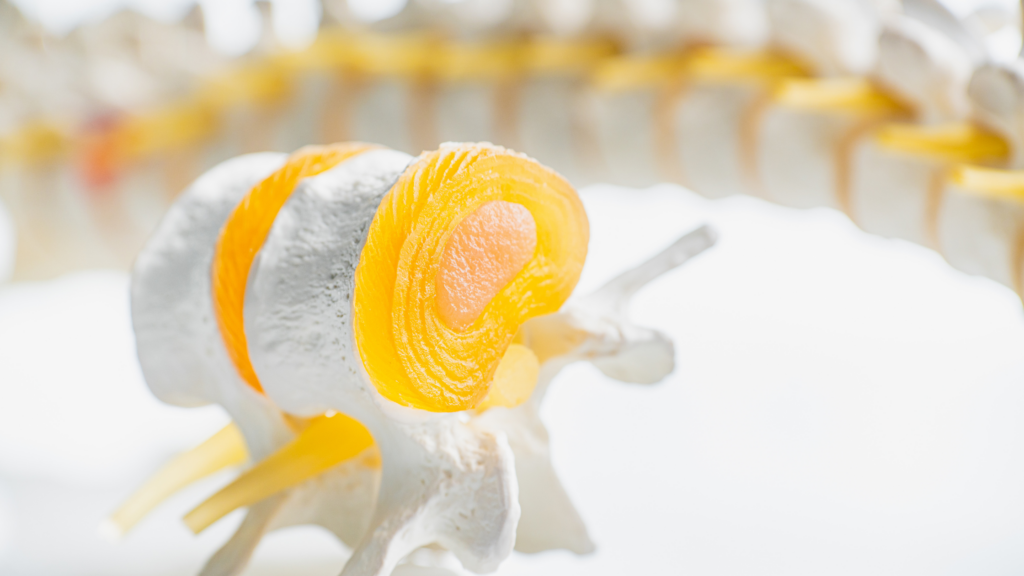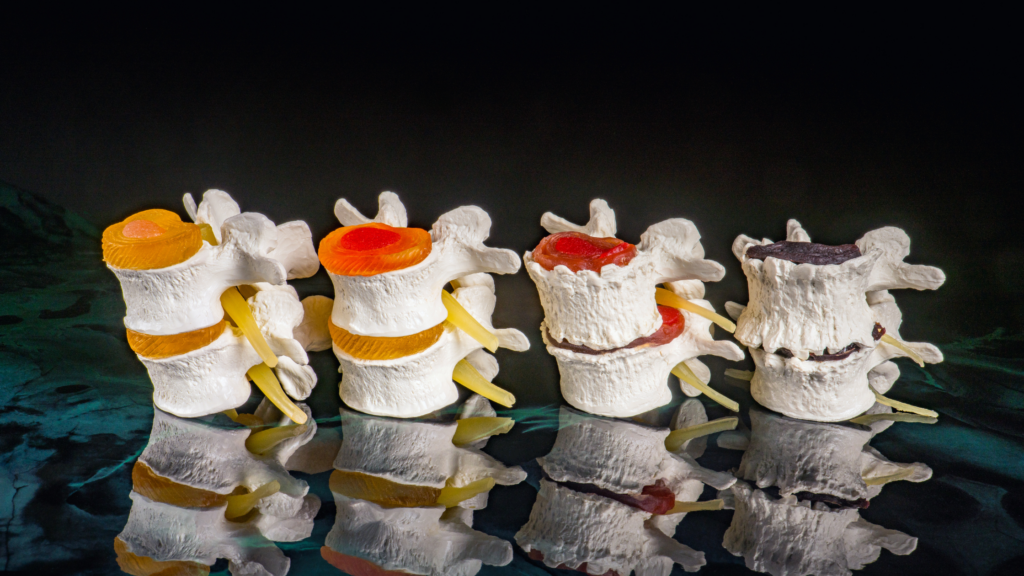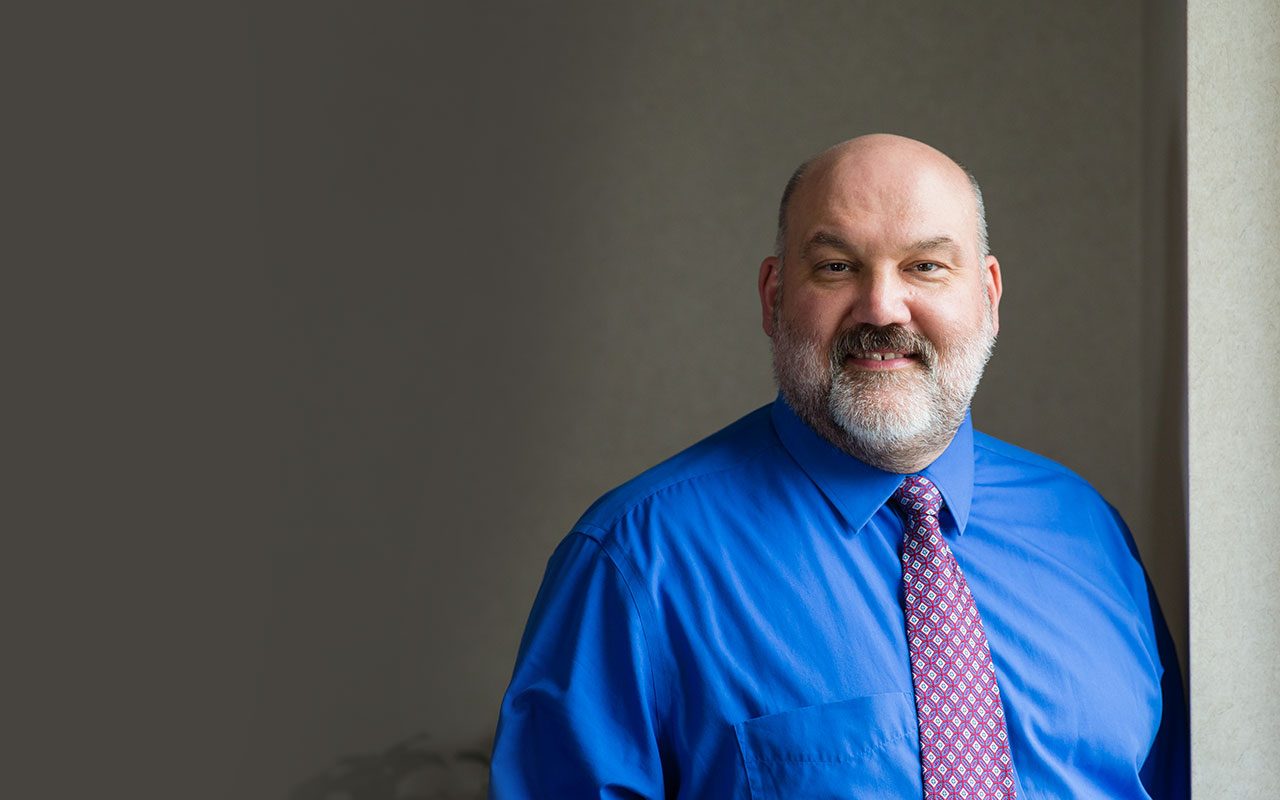A research study* found that stem cells injected into spine discs ended up in bone spurs (osteophytes) outside the disc. This was research on an animal spine, but it does raise two concerning issues for humans:
- Stem cells do not necessarily remain inside a disc after they are injected.
- When stem cells exit the disc via fissures (cracks), they “think they are helping” by growing bone spurs around the injured discs
It is precisely because of these two important issues that one might second guess a decision to have stem cell injections into the discs of the spine. The long-term consequence of doing so is not known in humans. An empowering non-surgical disc treatment alternative called Discseel does exist and will be discussed in greater detail at the end of this article. Let’s first review some important background details.
Disc Anatomy

The center of the disc is called the nucleus pulposus and has a gel-like consistency. The disc’s outer ring is called the annulus fibrosus and has a sturdier but still flexible structure.
Degenerative Disc Disease

Due to injury or degeneration, cracks start to develop in spine discs from the inside out. These cracks are called fissures and often correlate on an MRI with a high-intensity zone (HIZ) visible in the disc annulus. Sometimes MRI reports call these disc abnormalities “annular fissures” or “annular rents.” Because spine discs lack an adequate blood supply, these disc annulus fissures cannot heal spontaneously. As a result, these fissures extend in length and become more numerous with additional branching complexity over time. The discs themselves can become painful because of this process. As the discs wear down, they lose height and become flatter, which provokes the development of surrounding bone spurs to reinforce the degenerating discs. This process is called degenerative disc disease (DDD) and represents the normal progression of the disc “wear and tear.”
Stem Cell Disc Injections
Degenerative disc disease is a painful and frustrating condition because it can never get better on its own. Stem cell therapies are becoming more popular in several branches of medicine to treat many diseases. It seems inevitable that DDD and stem cell injections would collide. The goal of stem cell therapy is to stimulate the growth of body tissues to heal conditions and lessen pain.
Stem cells have been described as having “innate intelligence” and are influenced by their environment to transform into needed cells. Stem cells injected inside a disc are influenced to grow appropriate cells within the disc; however, cell growth in this environment is challenging due to the disc’s hostile acidic (low pH) environment caused by the inherent lack of blood supply. What if the stem cells grow tissue that we don’t want? Stem cells that escape outside the disc (via cracks) may be influenced by their new environment to advance the process of DDD, which involves the growth of bone spurs (osteophytes) – a very undesirable outcome.
The fundamental issue in the development and progression of DDD involves cracks (fissures) in the disc annulus. If the fissures remain, DDD progresses in a one-way, predictable direction. If the fissures remain, then any injected substance will not completely remain inside the disc long enough to make a substantial difference.
The key is sealing these disc fissures. This is precisely where Discseel comes in.
The Discseel® Procedure & How it Works
What is a long-term resolution if low back degenerative disc disease symptoms do not respond to appropriate conservative care? The Discseel® Procedure.
This procedure uses an FDA-approved biologic called Fibrin. The Fibrin is injected into the torn disc annulus, sealing the disc, representing the most important step in allowing a degenerative disc to recover.
The injection procedure is conducted using x-ray guidance and is performed in the office as an outpatient. The first step of this procedure is an Annulogram, where a water-soluble contrast is injected into the discs of the low back. Using live X-rays, Dr. Terebuh can see where there are leaks and tears, or degenerative changes in your spinal discs. After that, the Fibrin is injected into those specific areas that need to be treated. Learn more about Discseel at RegenerativeSpineAndJoint.com
Boris Terebuh, MD, is Ohio’s first, and most experienced licensed Discseel® provider. He and his team are highly skilled in providing relief from DDD. If you have made an informed decision to avoid low back surgery, then you owe it to yourself to determine if you are a Discseel candidate. If you or a loved one is currently suffering from degenerative disc disease, please fill out the form below to get in touch.
*Mesenchymal stem cell injection in degenerated intervertebral disc: Cell leakage may induce osteophyte formation. Journal of Tissue Engineering and Regenerative Medicine. 2012;6(5):348-355. Valada G, Sowa G, Hubert M, et al.

